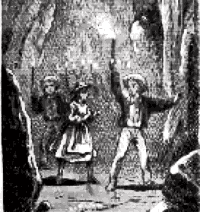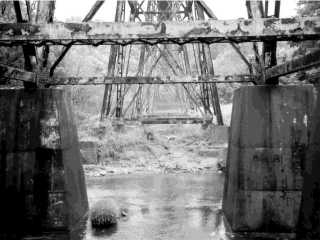Legend tripping
|
|
Legend tripping, in the folklore of the United States, is a name recently bestowed by folklorists and anthropologists on an adolescent rite of passage in which a usually furtive nocturnal pilgrimage is made to a site which is alleged to have been the scene of some tragic, horrific, and possibly supernatural event.
| Contents |
Origins
The concept of legend tripping is at least as old as Mark Twain's 1876 The Adventures of Tom Sawyer, which contains several accounts of adolescents visiting allegedly haunted houses and caves said to be the lairs of criminals. Tom Sawyer is based on lore that was current in Twain's own boyhood, and by Twain's time the main features of the ritual were already in place.
Much older versions of the custom may be glimpsed in traditional ballad tales such as the ballad of Tam Lin. In this ballad, a young woman is warned that the elf Tam Lin is known to haunt a place called Carterhaugh, and that all who go there must lose either an article of clothing or their virginity to Tam Lin. Janet, the heroine, defies the warning: she goes to Carterhaugh, picks a rose, encounters Tam Lin, and becomes pregnant with his child. She learns that Tam Lin was once human, and that to free him, she must make a second trip on Halloween night to a crossroads, where she has an encounter with the Queen of Elphame, and succeeds in reclaiming Tam Lin from fairyland.
In both the old ballad and in Mark Twain's version, there is a specific location that is supposed to be accursed, ghost-haunted, or otherwise dangerous. There is a folk story, of the type that is now called an urban legend, that explains why the place is haunted, accursed, or dangerous. The story is retold in preparation for the legend trip. In outward form, the legend is a cautionary tale warning of a danger; in practice, however, the cautionary tale is turned into a dare, inviting the trippers to go test its veracity. There is sometimes a ritual that must be performed at the site, the ritual is explained in the legend. The ritual invokes whatever dangerous spirits haunt that place.
The custom may be based on folk practices from the British Isles involving holy wells and similar shrines; on certain days of the year, young people would visit them, and these visits attracted attention on account of drinking and sexual activity at the site. In more recent times, legends have been reported in Britain concerning sites where the Devil, or an evil ghost, could be summoned by visiting a grave or a megalith and performing a ritual like running around it. In some of the British legends this must be done on a certain day or date, a condition seldom found in the United States. In Britain, too, certain headstones are said to be cursed: anyone who moves them will be cursed, and the stone will magically move back. In Britain as in the United States, the paradoxical effect of these warnings has been to encourage, rather than discourage, visitors.
Tales telling of marvels, wonders, or mysterious phenomena have excited human curiosity and inspired travel for centuries. What distinguishes legend tripping from other sorts of tourism is the notion of a dangerous experiment. The legends of legend trips typically warn of dangers. The legend trippers violate the tabooed site for the specific purpose of flirting with that danger. The legend trip is a specific ritual, and as such takes place in ritual time and ritual space. This creates a sort of mentally separate sphere in which the legend trip occurs, and allows the legend trippers to flirt with the dangers while minimizing their psychic effects in ordinary (i.e. non-ritual) life.
Sites for legend trips
While the stories that attach to the sites of legend tripping vary from place to place, and sometimes contain a kernel of historical truth, there are a number of motifs and recurring themes in the legends and the sites. Abandoned buildings, remote bridges, caves, and most importantly, cemeteries are frequent sites of legend-tripping pilgrimage.
The gravesite of the murderess Bloody Mary Worth is miraculously multiplied, and is said to exist in several locations in the United States, and usually is discovered wherever that story takes hold. Often there is a tale of a heinous crime that was committed at the site, and whose details are retold and multiplied in the legend that explains why the pilgrims are headed there.
Legend-tripping sites typically stand in relatively isolated and rural areas that are nevertheless easily reached by automobile, outside of major population centres. It is necessary for the legend to propagate, first that the adolescent pilgrims must be able to get there; and also, that the odds are good that they will be alone when they arrive.
The legend trip
The legend trip itself is usually made by car, by groups of at least three adolescents. On the way to the site, the legend is usually retold, and additional legends are told that tell of the frightening consequences of past legend trips to the site. Sometimes, sexual experimentation is part of the legend trip; like horror movies or frightening amusement rides, the legend trip environment encourages boys and girls to hold one another more closely. Less frequently, there is consumption of alcoholic beverages or recreational drugs.
Once the legend trippers arrive, they spend some part of the night there, and perform the ritual if one is prescribed as a means of daring and testing the evil spirit that haunts the place. The rituals are varied; in legend trips to cemeteries, there is usually a specific grave that the legend attaches to, and sometimes a tombstone that must be climbed, stepped on, sat on, or moved. As they retreat, they interpret any strange sounds, shadows, events, or dreams as evidence that the evil spirit has in fact been adequately tempted. Sometimes the grave is said to have the power to "heal" itself; if a legend tripper returns to the site, and the tombstone has been restored to its original position, the legend has been confirmed.
If the experience is well done, everyone leaves both scared out of their wits, believing that something uncanny did in fact happen as a result of the nocturnal rite, and most importantly, convinced of their own courage: they have successfully invoked and defied whatever haunts that place. They now have a story to tell, and a tradition to pass on to their immediate juniors.
Reactions and controversies
Legend-tripping is a mostly harmless, perhaps even beneficial, youth recreation. It allows young people to demonstrate their courage in a place where the actual physical risk is likely slight. However, the rituals enacted at the legend-tripping sites sometimes involve trespassing, vandalism, and other misdemeanors, and sometimes acts of animal sacrifice or other blood ritual. These transgressions then sometimes lead to local moral panics that involve adults in the community, and sometimes even the mass media. These panics, of course, embellish the prestige of the legend trip to the adolescent mind, and do nothing to discourage imitation.
The panic over youth Satanism in the 1980s was fuelled in part by graffiti and other ritual activities engaged in by legend-tripping youths.
Supernatural dares
Places without appropriate sites may still have rituals, often involving Ouija boards or similar divination devices, that seek to test teenage mettle by performing a dangerous magical ritual. The more excited adults become about these activities, the more mana they are believed to possess.
Legend tripping in popular culture
Legend-tripping is a motif in a number of horror films and horror stories.
- The film The Blair Witch Project succeeded largely because of its evocation of the atmosphere of adolescent legend trips.
- The film Candyman is also centered around adolescent supernatural rituals undertaken on a dare.
- The 1995 feature-length film of Casper the Friendly Ghost opens with a scene of teenagers investigating the haunted house.
- The Goosebumps book Don't Say Bloody Mary invokes and satirizes the "Bloody Mary" supernatural dare.
Places associated with legend tripping
- The Black Agnes statue, formerly in Baltimore, Maryland and now in Washington, DC (snopes.com external link (http://www.snopes.com/horrors/ghosts/agnes.htm))
- The grave of Captain Frances McHarry in Harrison County, Indiana
- The Lake View Public School, also known as the Gore Orphanage, near Cleveland, Ohio
- Mount Olive Cemetery in Butler, Ohio, home to the grave of a Bloody Mary type figure
- Church of the Winding Stair near Newcomerstown, Ohio
- The Myrtle Hill Cemetery in Medina County, Ohio
- The Pope Lick Trestle in Jefferson County, Kentucky, home to a satyr-like Pope Lick Monster
- Stepp Cemetery near Bloomington, Indiana
- The Waverly Hills Sanatorium, an abandoned hospital for tuberculosis victims, in Louisville, Kentucky
- The New Jersey Pine Barrens, said to be home to the Jersey Devil
See also
External links
- Legend Tripping in Ohio: The Gore Orphanage (http://www.lorain.lib.oh.us/history/Gore_Orphanage.html)
- The Mill: Trip to a Ghost Site in Manassas, Virginia (http://www.gmu.edu/folklore/nvfa/new/fairman.htm)
- Plains Folk: Legend Tripping (http://www.ext.nodak.edu/extnews/newsrelease/back-issues/000332.txt)
- The Waverly Hills Sanatorium (http://www.prairieghosts.com/waverly_tb.html)
- Weird New Jersey (http://www.weirdnj.com)
- Weird US (http://www.weirdnj.com/__weirdus/story_index.html)
- Ohio Trespassers - Ohio legends & Waverly Hills (http://www.ohiotrespassers.com)
References
- Aliens, Ghosts, and Cults: Legends We Live, by Bill Ellis (2001) ISBN 1578063256
- "Legend trip", entry in American Folklore: An Encyclopedia, ed. Jan Harold Brunvand (1996) ISBN 0815333501
- Lucifer Ascending: The Occult in Folklore and Popular Culture, by Bill Ellis (2004) ISBN 0813122899
- Raising the Devil: Satanism, New Religions, and the Media, by Bill Ellis (2000) ISBN 0813121701


